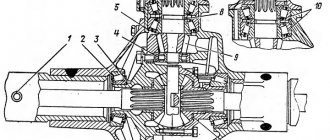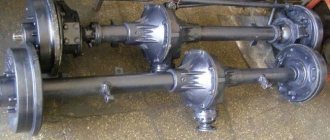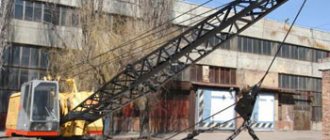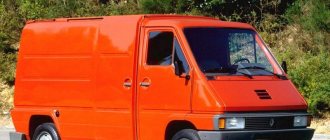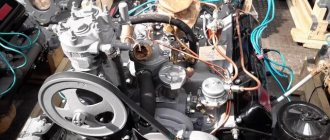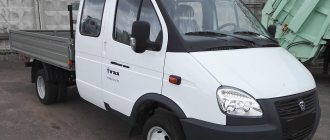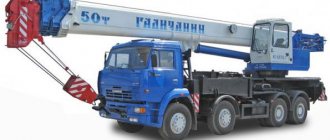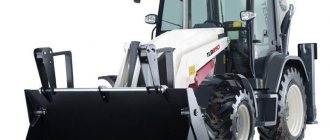Car engine
Despite the fact that the first production model of the car in question was released back in 1966, the technical characteristics of the engine in many areas satisfy the needs of the Russian army even today:
Thanks to its great power and high torque, the ZIL-131 could reach speeds of up to 85 km/h on the highway. Considering the year of manufacture, this parameter can be called quite impressive.
Not every passenger car of those years could move so fast, not to mention trucks of such a large mass.
The fuel consumption of the ZIL-131, shown in the photo on the right, with a mixed driving cycle is 49.5 liters per 100 km at an average speed of 60 km/h.
According to the technical specifications, the engine is designed to work with AI-76 gasoline or a similar one, but with a higher octane number.
Let's sum it up
35 years have passed from 1967 to 2002. During this time, the model in question was improved more than once, which had a positive effect on its performance. As a result, the “131” model, created at the Likhachev plant, received the highest award for the product - the USSR quality mark.
Despite the end of production and replacement with newer prototypes, the ZIL-131 is still found on the roads of the post-Soviet countries. Cars faithfully serve in various spheres of the national economy, realizing the plan set by the CPSU Congress back in 1959.
We advise you to read the article: ZIL - the history of the auto giant
KUNG and other modifications
The truck model in question turned out to be so successful that a large number of different modifications were produced on its basis.
ZIL-131 KUNG is especially popular. This abbreviation stands for “uniform body of zero overall size.”
Its frame is made of angles and channels of various sizes, sheathed on top with metal sheets.
And here we consider the Grunwald tipper, tilt and semi-trailer container carriers.
The inside of this ZIL-131 van body is lined with foam plastic or other heat-insulating material, after which everything is covered with antiseptic-coated plywood, which improves the technical characteristics of the entire vehicle.
Regardless of their purpose, all KUNG trucks in question are equipped with:
- heating;
- ventilation;
- all kinds of household equipment;
- lighting system (plafonds on the ceiling).
The uniqueness of the ZIL-131 KUNG was the presence in its body of a special filtration unit FVUA-100N-12.
It took air from the environment and disinfected it. Overpressure was created, which made it possible to protect the space inside the van.
The heating system was completely autonomous; heat was generated by burning diesel fuel.
Also, based on the truck in question, the following modifications with good technical characteristics were made:
- ZIL-131NA was equipped with leaky and unshielded equipment;
- ZIL-131V – truck tractor;
- ATZ-3 and similar ones were used as fuel tankers;
- MZ-131 – oil tankers;
- ATs-40 – fire engine.
Weight, dimensions, load capacity
The weight and overall characteristics of the vehicle of this type are relatively small, despite its main purpose. The parameters are as follows:
- curb weight of the model without winch – 6,135 kg;
- curb weight of the model with winch is 6,375 kg.
Although, according to the technical specifications, the weight of the winch mechanism of the ZIL-131 vehicle is quite significant, its presence is always justified, since it allows you to cope with movement in extremely difficult and extreme terrain conditions.
Gross vehicle weight:
- with a winch - 10,425 kg;
- without winch - 10,185 kg.
The maximum load capacity is only 3,500 kg. Also, if necessary, the equipment in question can be used in conjunction with a trailer.
Its permissible weight depends on the road conditions in which the ZIL-131 travels:
- weight when driving on a paved road – 6,500 kg;
- when driving on a dirt road – 4,000 kg.
The basic version of the car has the following overall dimensions:
- length from the front bumper to the rear of the body, mm – 7,040;
- height without awning, mm – 2,480;
- height with awning, mm – 2,975;
- width from left wheel to right, mm – 2,500.
The distance between the wheels is 3.35 m +1.25 m. The width of the front and rear tracks is the same and is 1.82 m. The turning radius is as much as 10.8 m. Considering the length of the body, this parameter is not that great.
The braking distance is 29 m at 50 km/h. The reason for this is the large inertia arising from the mass of the entire car and van with people, as well as all the equipment available.
Engine
ZIL-131 is equipped with a wide range of power units. But the most widely used versions are those with a gasoline engine, the ZIL-5081 model. This 8-cylinder, 4-stroke V-shaped carburetor unit is equipped with a “P-16B” heater, which ensures normal operation in winter. The engine has liquid cooling and low mass.
Power plant properties:
- working size – 5.97 l;
- rated power - 150 hp;
- highest torque – 402 Nm;
- rotation speed – 3200 rpm;
- cylinder diameter – 100 mm;
- compression ratio – 6.5.
For driving in dusty areas, the engine is equipped with a special foam-oil filter with a 3-stage air cleaning system. A reliable, high-capacity fuel pump allows uninterrupted operation at high temperatures.
Chassis design
The chassis of the car in question includes the following main components:
- governance mechanisms;
- chassis;
- main power train (transmission).
ZIL-131 control mechanisms include:
- power steering with mechanical connection to the front wheels;
- braking system.
The chassis includes the following components:
- frame;
- axles on which the wheels are located;
- pendants.
The final drive of this truck is double, its gear ratio is 7.34.
Truck Features
The organ that allows you to use it is located on the dashboard inside the cabin and is a regular metal two-position toggle switch.
Also, the front axle could be turned on using the gear shift lever.
The ZIL-131 gearbox is mechanical in its technical characteristics.
The second and third gears are equipped with special locks. They prevent the speed from being switched off inadvertently if the load on the engine increases rapidly. This is extremely important during a long climb.
For its year of production, the ZIL-131 is equipped with quite advanced electronics.
The design uses an alternator with a large power reserve, as well as contactless ignition with an electronic switching device.
In addition, there is a special vibration device that ensures movement for 30 hours without stopping on its own. All this was new for those years when the car in question began to be mass produced.
Car engine
Despite the fact that the first production model of the car in question was released back in 1966, the technical characteristics of the engine in many areas satisfy the needs of the Russian army even today:
Thanks to its great power and high torque, the ZIL-131 could reach speeds of up to 85 km/h on the highway. Considering the year of manufacture, this parameter can be called quite impressive.
Not every passenger car of those years could move so fast, not to mention trucks of such a large mass.
The fuel consumption of the ZIL-131, shown in the photo on the right, with a mixed driving cycle is 49.5 liters per 100 km at an average speed of 60 km/h.
According to the technical specifications, the engine is designed to work with AI-76 gasoline or a similar one, but with a higher octane number.
Power units
The serial onboard ZIL 131, the weight of which is indicated above, was standardly equipped with a four-stroke carburetor engine with 8 cylinders, a volume of 6 liters. The nominal power is 150 “horses”, the average fuel consumption is 36-39 l/100 km. The engine belongs to the overhead valve group and has a liquid cooling type.
In 1986, they began installing an improved unit with a capacity of 150 horsepower on some modifications. It differed from its predecessor in the cylinder block, the heads of which received helical-type intake valves and increased compression (7.1). In addition, the engine has become more economical than its standard counterpart.
Diesels were rarely installed on the designated truck. For these purposes, the following types of motors were used:
- D-245.20. Engine with in-line placement of 4 cylinders, volume 4.75 liters. Power - 81 hp. s, fuel consumption - 18 l/100 km.
- ZIL 0550. Own-produced unit with 4 strokes, volume 6.28 liters, power rating 132 hp. With.
- YaMZ-236. V-shaped engine with six cylinders, volume 11.1 liters, power 180 “horses”.
KUNG and other modifications
The truck model in question turned out to be so successful that a large number of different modifications were produced on its basis.
ZIL-131 KUNG is especially popular. This abbreviation stands for “uniform body of zero overall size.”
Its frame is made of angles and channels of various sizes, sheathed on top with metal sheets.
And here we consider the Grunwald tipper, tilt and semi-trailer container carriers.
The inside of this ZIL-131 van body is lined with foam plastic or other heat-insulating material, after which everything is covered with antiseptic-coated plywood, which improves the technical characteristics of the entire vehicle.
Regardless of their purpose, all KUNG trucks in question are equipped with:
- heating;
- ventilation;
- all kinds of household equipment;
- lighting system (plafonds on the ceiling).
The uniqueness of the ZIL-131 KUNG was the presence in its body of a special filtration unit FVUA-100N-12.
It took air from the environment and disinfected it. Overpressure was created, which made it possible to protect the space inside the van.
The heating system was completely autonomous; heat was generated by burning diesel fuel.
Also, based on the truck in question, the following modifications with good technical characteristics were made:
- ZIL-131NA was equipped with leaky and unshielded equipment;
- ZIL-131V – truck tractor;
- ATZ-3 and similar ones were used as fuel tankers;
- MZ-131 – oil tankers;
- ATs-40 – fire engine.
Weight, dimensions, load capacity
The weight and overall characteristics of the vehicle of this type are relatively small, despite its main purpose. The parameters are as follows:
- curb weight of the model without winch – 6,135 kg;
- curb weight of the model with winch is 6,375 kg.
Although, according to the technical specifications, the weight of the winch mechanism of the ZIL-131 vehicle is quite significant, its presence is always justified, since it allows you to cope with movement in extremely difficult and extreme terrain conditions.
Gross vehicle weight:
- with a winch - 10,425 kg;
- without winch - 10,185 kg.
The maximum load capacity is only 3,500 kg. Also, if necessary, the equipment in question can be used in conjunction with a trailer.
Its permissible weight depends on the road conditions in which the ZIL-131 travels:
- weight when driving on a paved road – 6,500 kg;
- when driving on a dirt road – 4,000 kg.
The basic version of the car has the following overall dimensions:
- length from the front bumper to the rear of the body, mm – 7,040;
- height without awning, mm – 2,480;
- height with awning, mm – 2,975;
- width from left wheel to right, mm – 2,500.
The distance between the wheels is 3.35 m +1.25 m. The width of the front and rear tracks is the same and is 1.82 m. The turning radius is as much as 10.8 m. Considering the length of the body, this parameter is not that great.
Description
The first ZIL-131 vehicles were intended to transport not only cargo, but also people, so folding benches for 16 seats were installed in a plank body with a folding tailgate, and one eight-seater bench was separate.
On the sides there were dismantled arches for the awning, which made it possible to cover people and cargo in case of bad weather. In this form, with flatbed bodies, the first vehicles were produced and immediately entered service with the army, came to collective farms, and to large construction sites.
Army airborne vehicles were supplied with:
- observation hatch. It was located on the right in the roof of the cabin;
- blackout headlights and a finder headlight on the left;
- strengthening the windshield in the form of a B-pillar;
- fastening devices for road transportation.
The vehicles were equipped with a special kit, which included:
- drill sockets for weapons,
- night-vision device,
- box for documents and cards,
- dosimeters;
- tools for engineering earthworks;
- fire fighting equipment and first aid kit.
Slightly modernized, on-board vehicles with a winch and a platform above the top of the cabin, additional lighting, and marked with special signs, provided the missile systems with special equipment, carried out reloading and delivery of equipment.
The video shows a comparison of diesel and gasoline ZIL-131.
Chassis design
The chassis of the car in question includes the following main components:
- governance mechanisms;
- chassis;
- main power train (transmission).
ZIL-131 control mechanisms include:
- power steering with mechanical connection to the front wheels;
- braking system.
The chassis includes the following components:
- frame;
- axles on which the wheels are located;
- pendants.
The final drive of this truck is double, its gear ratio is 7.34.
Truck Features
The organ that allows you to use it is located on the dashboard inside the cabin and is a regular metal two-position toggle switch.
Also, the front axle could be turned on using the gear shift lever.
The ZIL-131 gearbox is mechanical in its technical characteristics.
The second and third gears are equipped with special locks. They prevent the speed from being switched off inadvertently if the load on the engine increases rapidly. This is extremely important during a long climb.
For its year of production, the ZIL-131 is equipped with quite advanced electronics.
The design uses an alternator with a large power reserve, as well as contactless ignition with an electronic switching device.
In addition, there is a special vibration device that ensures movement for 30 hours without stopping on its own. All this was new for those years when the car in question began to be mass produced.
Cabin
The cabin on the ZIL-131 is of a frame type, the outside is sheathed with sheet metal, and the inside has various types of insulation. Its presence allows the driver to feel comfortable even in severe frost.
All moving elements are equipped with special rubber seals; their presence allows the closure to be as tight as possible.
The car's dashboard contains everything necessary to monitor the main engine parameters:
- gasoline level sensor;
- voltmeter/ammeter;
- speedometer;
- oil pressure sensor;
- temperature sensor;
- tachometer.
All controls necessary for comfortable operation of the car are within reach of the driver.
The turn control lever is located on the steering column. Everything else is on the dashboard to the right of the tachometer.
The control handles have the most suitable shape for grip, which allows you to perform various operations with maximum convenience.
The driver and passenger seats do not have many adjustments.
But, despite this, being in this cabin is quite pleasant: the designers made the seats taking into account the anthropometric parameters of the average person. Therefore, most drivers can drive the ZIL-131 with great comfort.
This review examines the advantages and disadvantages of the Amkodor 352 backhoe loader.
By following the link https://spez-tech.com/tehnika/selhoz/pritsepyi-i-polupritsepyi/gazel-avto/tyagach-s-funktsional-gruzovika-i-mobilnost-legkovogo.html, you will find information not only about possible prices for a GAZelle tractor with a semi-trailer, but also a description of the main types of this type of transport.
The cabin is equipped with impressively sized rear-view mirrors. Their viewing angle makes it possible to easily see everything that is behind the cab, even if the movement is carried out with a special trailer.
Despite the fact that the model has been produced for quite some time, it is still in demand because it is distinguished not only by its durability and versatility, but also by its low cost.
The price of a specific car directly depends on the year of manufacture, mileage and condition:
Dump truck ZIL-131: history
The first car of the ZIL-131 brand rolled off the assembly line in 1966. By 1986, production of these machines was discontinued. The basic version of the dump truck was replaced by a modernized version of the ZIL-131N. All-terrain vehicles began to be equipped not only with a gasoline carburetor engine, but also with various models of diesel power units.
During mass production, the plant managed to develop several modifications: with and without winches, with leaking electrical equipment, truck tractors and dump trucks, and equipment for cold regions. Based on the ZIL-131 chassis, special vehicles were produced, adapted for various equipment from tankers to army vehicles.
The Moscow plant stopped producing ZIL-131 in 1994. Production of the ZIL-131N was moved to the Ural Automotive Plant, where it continued until 2002. The car was then replaced by a new version. The chassis for special equipment is still produced.
